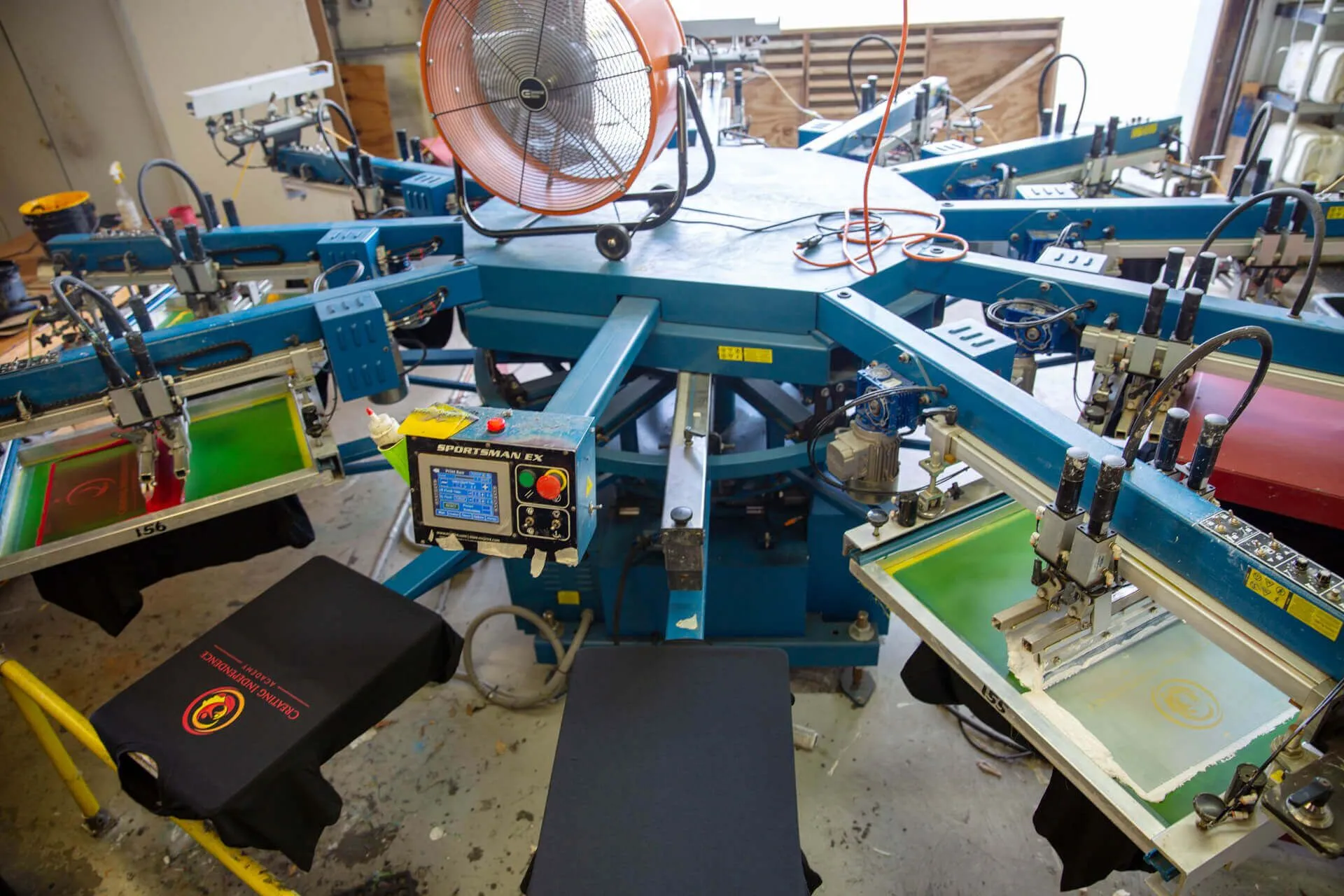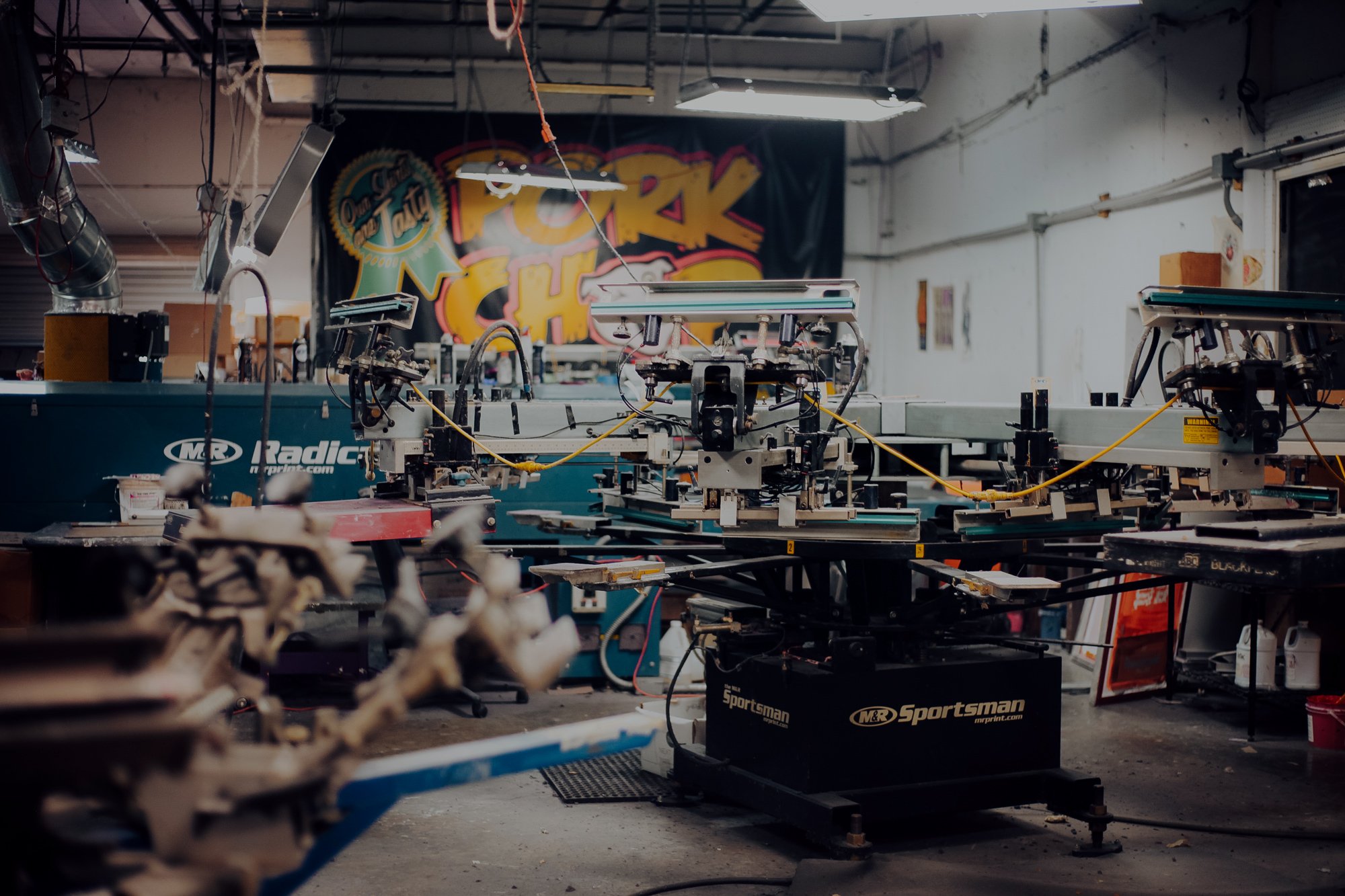High-End Silk Screen Printing for Premium Garments
High-End Silk Screen Printing for Premium Garments
Blog Article
Screen Printing Uncovered: Every Little Thing You Required to Find Out About T-Shirt and Garment Printing Techniques
Display printing is a fascinating method that incorporates art with method, providing countless opportunities for imagination. Ready to explore the crucial components that make display printing an art form?
The Essentials of Display Printing: Exactly How It Works
When you dive right into screen printing, you'll uncover it's both an art and a scientific research. At its core, display printing includes creating a pattern, or screen, that permits ink to pass with only in certain areas.
Next, you'll mix your inks and prepare your printing surface area. Position the screen over the textile, after that use a squeegee to press ink via the screen onto the garment. This procedure needs accuracy, as you want clear, lively prints. After printing, you'll treat the ink with warm, guaranteeing it follows the material and lasts through cleans. Each step is important, and understanding them will certainly boost your screen printing skills, changing straightforward garments right into unique, expressive pieces.
Kinds Of Screen Printing Techniques
Once you understand the fundamentals of screen printing, it's time to explore the various techniques that can elevate your layouts. One preferred method is conventional screen printing, where ink is pressed with a stenciled display.
If you're intending for great details, think about discharge printing. This method eliminates dye from the textile, leaving a soft, classic appearance. One more choice is plastisol printing, known for its longevity and brilliant shades, making it a favorite for many brands. Ultimately, experiment with halftone printing to develop gradient effects and complex layouts. Each method has its distinct beauty, so do not think twice to attempt them bent on locate what suits your design best!
Vital Equipment for Display Printing
To attain magnificent outcomes in screen printing, having the appropriate tools is essential. You'll need a durable display printing structure, which holds the mesh that transfers your style onto the garment. Next, invest in high-grade mops; these are important for applying ink evenly across the screen.
Selecting the Right Inks and Materials
When picking inks and products for display printing, you need to think about the kind of ink that functions ideal for your job. Think about material compatibility to assure your styles look last and terrific long. Additionally, discover eco-friendly ink choices to make your printing procedure much more lasting.
Sorts Of Screen Inks
Picking the right screen ink is essential for attaining lively, resilient prints that fulfill your job's requirements. There are numerous types of display inks to examine. Specialty inks, such as metal or glow-in-the-dark, can include one-of-a-kind results to your styles.

Material Compatibility Considerations
Understanding fabric compatibility is important for achieving premium screen prints, especially because different products respond distinctively to different inks. Always evaluate your inks on example fabric to ensure they adhere appropriately and preserve shade stability. In addition, maintain in mind that material weight and structure can affect the final end result, so picking the right ink and material combination is important for your task's success.
Eco-Friendly Ink Options
Environment-friendly inks are ending up being a popular option for display printers who wish to reduce their ecological impact while preserving top quality. When picking inks, consider water-based inks, which are much less hazardous and much easier to tidy up compared to typical solvents. These inks bond well with fabrics, supplying lively outcomes without toxic chemicals. You may additionally check out eco-solvent inks that use fewer unstable organic substances (VOCs), making them a more secure option for both your health and the world.
Additionally, search for inks made from renewable energies, such as soy or vegetable-based choices. By selecting the right inks and materials, you'll not just create stunning layouts yet additionally contribute to a more lasting printing process. Make the switch, and your prints will reflect your dedication to the environment!
Preparing Your Design for Display Printing

Submit Format Requirements
To assure your design looks sharp and vibrant on fabric, you'll need to pay attention to file style needs for screen printing. Start with vector files like AI or EPS, as they can be scaled without losing high quality. If you make use of raster images, select high-resolution documents, such as TIFF or PNG, preferably at 300 DPI. Stay clear of utilizing JPEGs, as they can lose quality when resized. Make certain your style has a transparent background to protect against unwanted white sides on your prints. Finally, keep color modes in mind; CMYK is conventional for display printing, so convert your RGB makes appropriately. By following these guidelines, you'll establish your artwork up for a successful print.
Color Splitting Up Strategies
Color separation is a vital action in preparing your style for screen printing, and understanding it can significantly boost your print high quality. You'll require to damage your layout into individual colors, as more information each shade calls for a different display see this during printing. This accuracy not only guarantees precise shade representation but also improves the printing procedure.
Resolution and Size
Achieving the very best lead to screen printing begins with ensuring your design has the right resolution and size. Preferably, your artwork ought to be at least 300 DPI (dots per inch) for sharp, clear prints. Your last product might look pixelated and amateur. if you make use of reduced resolution.
When it pertains to size, take into consideration the dimensions of your print area. Layout your art work to match the last print dimension, ideally producing it in the real dimensions you'll be publishing. In this manner, you'll prevent any unanticipated scaling issues.
Constantly inspect your style in both vector and raster layouts. Vector graphics can be scaled without shedding quality, making them suitable for display printing. Preparing properly will guarantee your design looks impressive on every garment!
Step-by-Step Screen Printing Refine
Screen printing is a vibrant process that permits you to develop lively designs on different surfaces. To obtain started, you'll need a display, emulsion, and your picked ink.
Pour ink onto the screen and use a squeegee to press the ink with the pattern onto the textile. Raise the screen very carefully and let the print dry. You've effectively display published your design.
Tips for Effective Screen Printing Projects
While you're diving into your screen printing jobs, bear in mind that prep work is vital to success. Begin by gathering all your products-- inks, displays, squeegees, and garments. A clean workspace assists protect against undesirable mistakes, so neat up before you begin.
Next, validate your art work is high-resolution and correctly sized for your garment. Check your screen for correct exposure and tidy it completely to avoid spots. When blending your inks, follow the producer's guidelines to accomplish the best uniformity.
Throughout printing, use also Find Out More pressure with your squeegee for consistent results. Don't hurry; take your time to validate each print satisfies your criteria. After printing, let your garments completely dry totally before managing or packaging them.
Finally, always maintain a sample of your help future reference. This method, you can analyze your development and enhance your strategies gradually. Pleased printing!

Often Asked Inquiries
How Lengthy Does It Require To Establish a Screen Printing Task?
Setting up a display printing work generally takes around half an hour to an hour. You'll prepare the screens, mix inks, and readjust the press. The time varies based upon complexity and experience, so stay arranged!
Can I Publish on Various Textile Keys In Making Use Of the Same Strategy?
Yes, you can print on different textile kinds making use of the very same strategy, however you'll require to adjust your inks and setups. Some textiles take in ink differently, so experimenting guarantees the most effective outcomes for each product.
What Are Typical Errors to Avoid in Screen Printing?
When screen printing, avoid usual mistakes like making use of the incorrect ink, disregarding appropriate exposure times, or skipping pre-press checks. Constantly evaluate your configuration and maintain tidy displays to ensure high quality results each time.
Exactly How Can I Correctly Tidy and Keep My Display Printing Devices?
To appropriately clean and maintain your display printing tools, you must regularly wash displays with proper solvents, check squeegees for wear, and guarantee all devices are saved dry and dust-free. Uniformity avoids costly repairs and boosts performance.
Is Display Printing Eco Pleasant Compared to Various Other Approaches?
Screen printing can be much more ecologically pleasant than various other methods, especially if you make use of eco-conscious materials and water-based inks. By selecting sustainable products and methods, you reduce waste and lessen your effect on the earth.
Screen Printing Uncovered: Everything You Required to Know About Tee and Garment Printing Strategies
At its core, screen printing includes producing a pattern, or screen, that enables ink to pass through just in certain areas. Placement the screen over the textile, after that make use of a squeegee to press ink through the screen onto the garment. One prominent approach is conventional display printing, where ink is pressed with a stenciled screen.When choosing inks and products for display printing, you require to take into account the type of ink that works ideal for your project.
Report this page